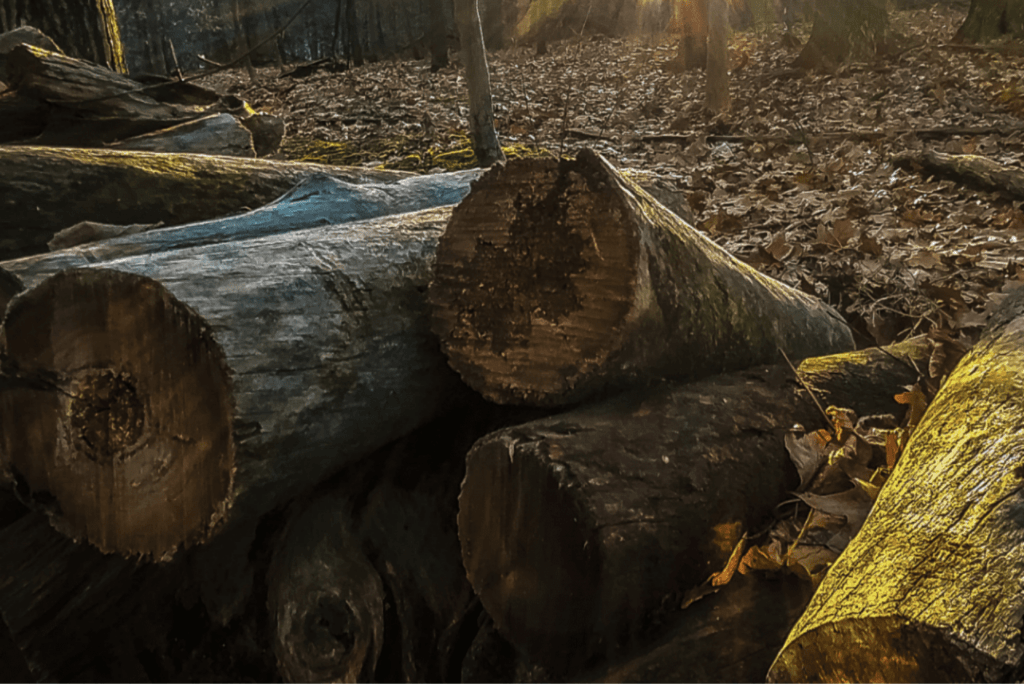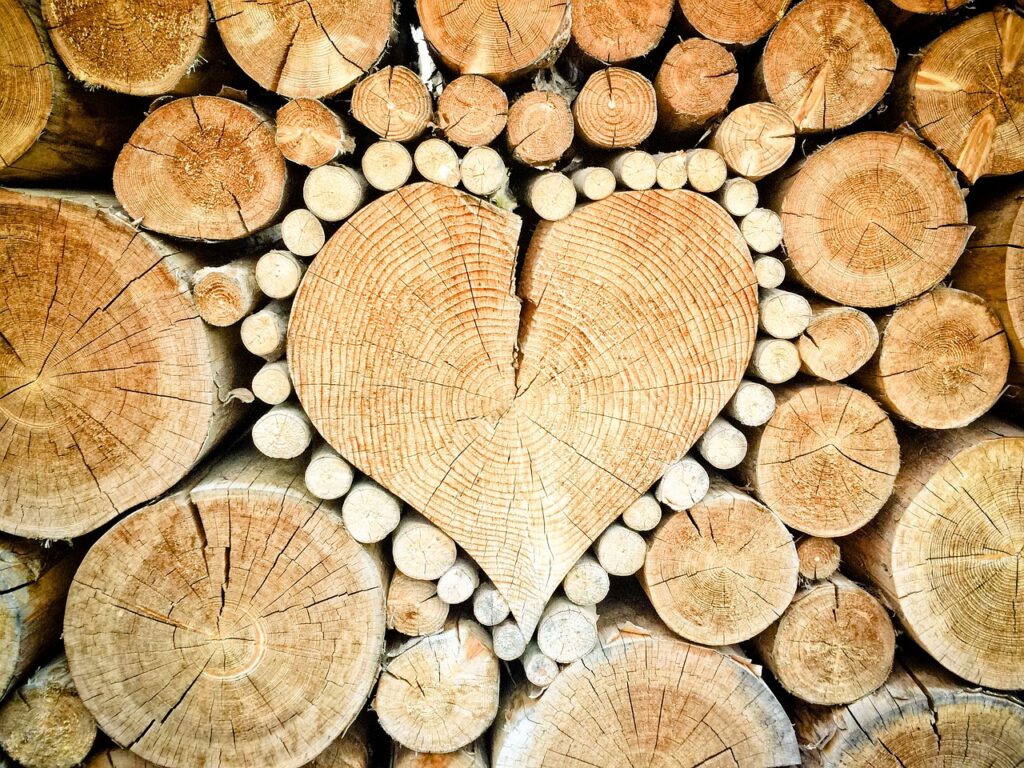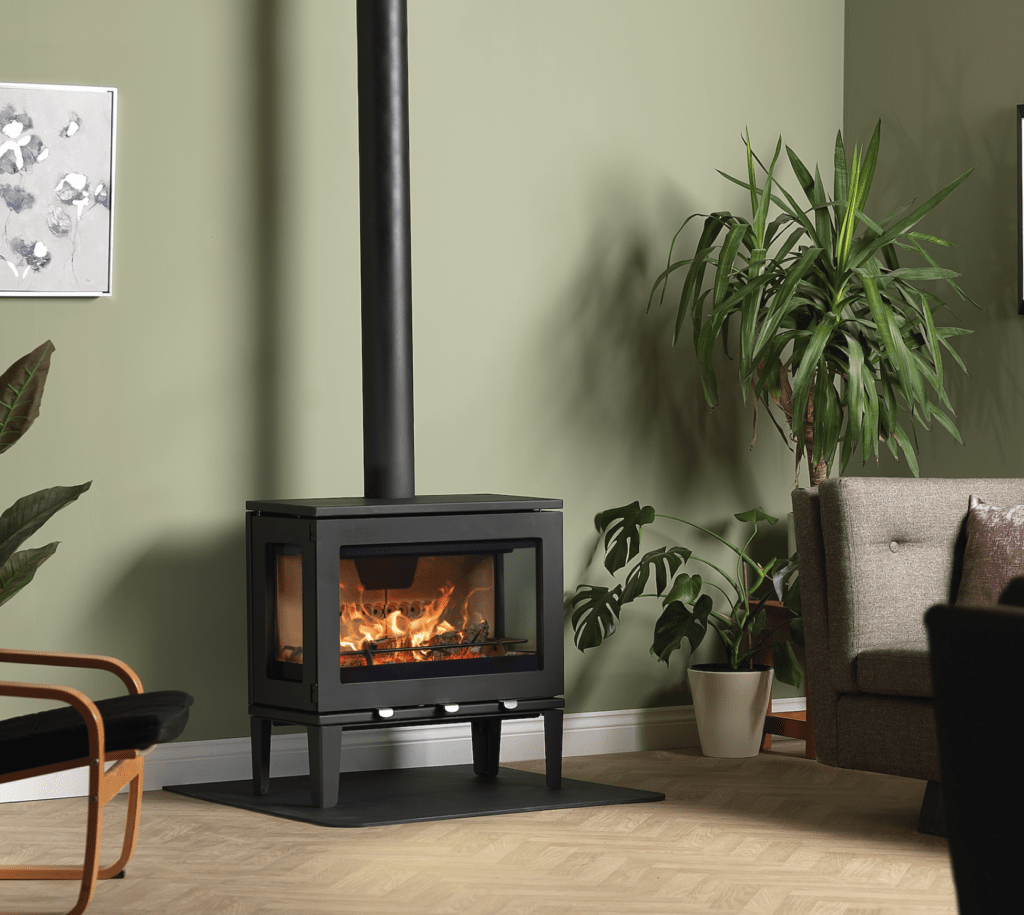Wood-burning stoves have experienced a surge in sales in recent years as homeowners seek carbon-neutral heating alternatives. Firewood, when sourced from well-managed woodlands, can provide a renewable source of heat for homes. The key is sustainably managing forests so that we harvest wood without depleting or degrading the woodland ecosystems. There is a range of woodlands that can provide sustainable firewood, where sustainable forestry practices are key in creating an effective carbon cycle of wood fuel.
Woodlands come in many forms, each offering unique ways to produce firewood sustainably. In the UK, there are three broad woodland types that are particularly relevant: coppiced woodlands, native mixed forests, and plantations (including energy crops).

Coppiced Woodlands: Renewable by Tradition
Coppicing is an ancient woodland management technique that is ideally suited for producing renewable firewood. In a coppiced woodland, trees are periodically cut down to the stump (or “stool”), stimulating vigorous regrowth of multiple shoots. After a cycle of several years, the new stems are harvested, and the process repeats, allowing the same tree stumps to yield wood again and again for centuries. This traditional method was once widespread in Britain to produce charcoal, firewood, and poles, and it is experiencing a revival today. Coppiced woodlands can provide a steady, sustainable supply of logs because no new planting is needed; the trees continually regenerate after cutting.
Coppicing works best with certain species. Hazel and sweet chestnut are classic coppice trees, valued because they grow durable wood but are less in demand as large timber. Other native hardwoods like oak, ash, and beech can also be coppiced, though in practice these are often left to grow into standard (tall) trees for higher-value timber. A well-managed hazel or chestnut coppice might be divided into sections (coupes) and harvested in rotation (typically every 7–20 years per section). Each year, one coupe is cut and others are left to regrow, creating a continuous cycle of production. This rotational coppicing yields a reliable annual firewood crop without exhausting the woodland.
Beyond fuel output, coppice management greatly benefits woodland wildlife. At any time, different coppice coupes are at different stages of regrowth, some open and recently cut, others in dense thickets. This patchwork structure creates diverse habitats that boost biodiversity. Dormice, nightingales, and butterflies like the pearl-bordered fritillary thrive in coppiced woods, and the increased sunlight in freshly cut areas allows wildflowers (primrose, violets, bluebells, etc). In essence, coppicing simultaneously produces renewable wood fuel and a richer ecology. Many neglected coppice woodlands in the UK are now being restored, recognising that this age-old practice is a win-win for sustainable firewood and conservation.
Native Mixed Forests: Multi-Functional Woodlands
The UK’s native mixed forests, typically dominated by broadleaf species (oak, birch, ash, beech, etc.), can also supply firewood as part of their management. These woodlands are usually managed for multiple benefits: wildlife habitat, recreation, timber, and also wood fuel. Sustainable harvesting in mixed woodlands often involves selective felling or thinning. This means periodically removing certain trees (for example, weaker or crowded stems), which yields logs for firewood while giving the remaining trees more space and light to grow.
Thinning improves the overall health and resilience of the forest, and the removed wood can be used as domestic fuel instead of going to waste.
In well-managed native woodlands, firewood is essentially a useful by-product of good forestry. Dead or storm-fallen trees can be logged for fuel, and routine pruning or thinning provides off-cuts suitable for burning. Importantly, such harvesting is done at a rate the forest can continuously regenerate. Management plans typically follow principles like those in the UK Forestry Standard, which require that any larger-scale felling is coupled with replanting or natural regeneration of trees.
Native woodlands managed under these guidelines can continue to provide a modest yield of firewood indefinitely. At the same time, they maintain their ecological integrity, especially if care is taken to preserve ancient trees, leave some dead wood for wildlife, protect soil and water quality, and keep a mix of tree species. Many British broadleaf woodlands historically had a “coppice-with-standards” system: a mix of coppiced understorey and big standard trees. Reviving traditional management practices today can enhance biodiversity and produce home-grown fuelwood, reducing reliance on fossil fuels.

Plantations and Energy Crops: High-Yield Wood Fuel Sources
Plantations are more intentionally cultivated forests, often featuring faster-growing trees or even single species, designed to produce wood in high volumes. In the context of firewood production, plantations can take several forms. One common type in the UK is conifer plantations, such as those of Scots pine or Sitka spruce. These are typically grown for timber, but they also contribute to a sustainable fuel supply.
Thinning operations in conifer plantations, where select trees are removed during the growth cycle, yield a substantial amount of wood that may not be sawmill quality but can be cut into logs or wood chips for fuel. When the plantation is eventually clear-felled for timber, the smaller branches and off-cuts can be recovered as biomass fuel. As long as the plantation is replanted after harvest (a standard practice), this forms a renewable cycle. Modern forestry aims to avoid the old monoculture approach; even plantations now often include mixed species or mosaic planting to reduce disease risk and support biodiversity. For example, UK guidelines limit single-species areas and encourage diversity in replanting, such as oak, ash, and beech, which can also be coppiced.
Another category is short-rotation energy crops, essentially fast-growing trees grown specifically for fuel. Short Rotation Coppice (SRC) typically involves species such as willow or poplar, which are planted densely and harvested every 2–5 years for biomass. These are often cut by machine and used for wood chips or pellets rather than logs, but they represent a high-yield source of renewable wood fuel. On suitable sites, SRC willow or poplar can produce on the order of 7–12 oven-dried tonnes of wood per hectare annually, a rate of production far exceeding that of natural forests. The trade-off is that these are more like agricultural crops, requiring intensive planting, tending, and mechanised harvest, and they primarily supply larger-scale biomass boilers or power plants. However, smaller-scale plantations of fast-growing trees can also be managed by smallholders to produce logs for home use. Some farmers and landowners in the UK and Europe plant poplar, willow, or hybrid aspen in rotations aimed at providing a local firewood supply within a decade or two of growth.
In summary, plantations (whether traditional conifer forests or dedicated energy woodlots) can be part of the sustainable firewood picture. They yield large quantities of wood and, if managed under sustainability standards, ensure continuous replanting and minimal ecological disruption. Plantations are most effective when viewed as one component of a broader landscape approach – for instance, using them to take pressure off natural woodlands by meeting a chunk of wood fuel demand, while native woods are managed more for biodiversity and lighter harvesting.
Woodland Management for Long-Term Firewood Yields
Regardless of the woodland type, sustainable forest management practices are crucial for producing firewood indefinitely without degrading the forest. Effective management strikes a balance between extraction and regrowth, promoting ecosystem health.

Key practices include:
Harvest at the forest’s growth rate: A fundamental rule is to never remove wood faster than the trees can regrow. In practical terms, foresters calculate an annual allowable cut or rotation cycle based on how quickly the woodland accumulates new growth (increment). For example, a small wood might sustainably yield a few cubic meters of firewood per year if that’s equal to its annual growth. By maintaining harvest levels within the forest’s natural productivity, the supply can continue indefinitely.
Use rotation and regenerative harvesting: Techniques like coppicing follow rotation cycles that give trees time to regenerate between cuts. In larger forests, managers often employ continuous cover forestry or selective felling, removing only some trees and allowing the canopy to continually regenerate. This avoids large clear-cuts except where necessary. If a section of woodland is felled more extensively, replanting or natural seeding is ensured afterwards so that forest cover is maintained. Essentially, every tree taken for firewood is replaced by new growth, either from stump sprouts or new seedlings.
Protect soil and water: Logging operations for firewood should minimise damage to the forest floor and waterways. Heavy machinery is kept on designated tracks; felling is timed to avoid very wet conditions that could churn up the soil. This prevents erosion and maintains the nutrient-rich soil that new trees need. By safeguarding the growing conditions, the forest can continue to renew itself after each harvest.
Maintain biodiversity and habitat: Sustainable management isn’t just about trees, it considers wildlife and plant communities too. Leaving some dead wood and older trees untouched provides habitat for birds, insects, and fungi. Creating a mix of light and shade conditions (for example, small gaps or coppice coupes) supports a variety of species. Even in a productive woodland, certain areas might be set aside or harvest rotations extended to allow old-growth features to develop. The UK Forestry Standard addresses such considerations, requiring attention to species diversity, the conservation of important habitats, and limits on practices such as large-scale clear-felling. In practice, a wood managed for firewood can also host wildflower glades, nesting birds, and other natural values, the management plan simply needs to integrate ecological goals with production.
Plan for the long term: Forests operate on decades-long timescales. A sustainable firewood plan looks ahead to ensure the woodland will be as productive and healthy in 50 or 100 years as it is now. This means planting and regeneration are continuous. Young trees are tended to replace older ones eventually. Climate change is also factored in: choosing tree species resilient to future conditions (and resistant to pests) helps guarantee future growth. The UK, for instance, encourages planting a mix of species and favouring native varieties or well-adapted cultivars so that woods are more resilient to disease outbreaks or extreme weather. By investing in the next generation of trees whenever wood is harvested today, we effectively renew the fuel supply for future generations of homeowners.
When these sustainable practices are followed, a woodland can yield firewood year after year without any decline in its vitality. In fact, active management often improves forest health and diversity. Removing some wood can open up space for remaining trees and foster a diversity of ages and species, creating a more robust forest. This stands in contrast to “mining” a forest unsustainably – for example, over-harvesting for a quick profit leads to depleted woods that can take decades to recover, if ever. Fortunately, the UK has strong regulations and guidelines (like the Forestry Commission’s oversight on felling licenses and the UK Forestry Standard) to ensure woodland owners manage responsibly. By adhering to these, landowners can provide local communities with a steady stream of firewood while keeping forests thriving.

Wood Fuel and the Carbon Cycle: Low-Carbon Heating from Trees
A major appeal of burning wood for heat is that it can be carbon-neutral or very low-carbon, unlike fossil fuels. The basic idea is simple: as trees grow, they absorb carbon dioxide (CO₂) from the atmosphere and store it in wood. When we burn that wood, the CO₂ is released, but if new trees are growing to replace the ones harvested, they will absorb an equivalent amount of CO₂. In a well-managed system, the carbon emitted by your wood-burning stove is roughly balanced by the carbon being sequestered in new tree growth, resulting in little to no net addition of CO₂ to the atmosphere. This closed carbon loop is what makes wood a renewable energy.
In contrast, burning fossil fuels like gas or oil releases carbon that was locked underground for millions of years, adding new CO₂ to the current atmosphere. Wood’s carbon, by comparison, is part of the biogenic carbon cycle; it was in the air perhaps just decades ago, taken in by a tree, and will be taken up again by trees in years to come. For this reason, policymakers consider wood heating a form of renewable energy in their carbon targets. Many rural households using efficient wood stoves are effectively cutting their carbon footprint for heating by displacing gas or electric heating.
Conclusion:
Woodland-sourced firewood is a key component of the carbon-neutral heating puzzle. When we manage woodlands conscientiously, whether it’s an English coppice or a Scottish pine plantation, we unlock a renewable heat supply that can last indefinitely. A single woodland, nurtured through cycles of harvest and regrowth, could warm local homes for generations. This not only replaces fossil fuel use (shrinking our carbon footprint) but also ties people closer to nature and encourages the expansion and care of forests. The practices described, from coppicing and selective felling to replanting and using efficient stoves, ensure that we take wood in a way that the forest can sustain and even benefit from.
In the UK, support for sustainable firewood is growing at both grassroots and policy levels. Homeowners are increasingly mindful of seasoning their logs and upgrading to ecodesign stoves; meanwhile, government strategies and certifications guide the sourcing and burning of wood to minimise its environmental impact. The result is that wood heating is shedding its old image and becoming a modern, viable component of low-carbon living. Of course, it’s not a one-size-fits-all solution; urban areas will always have limits on wood burning, and not everyone can access a woodland. But for many, particularly in rural and suburban settings, firewood from well-managed woodlands can provide a substantial portion of home heating needs in a sustainable way.








